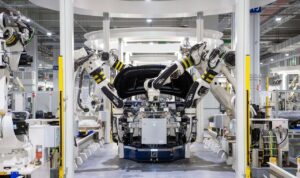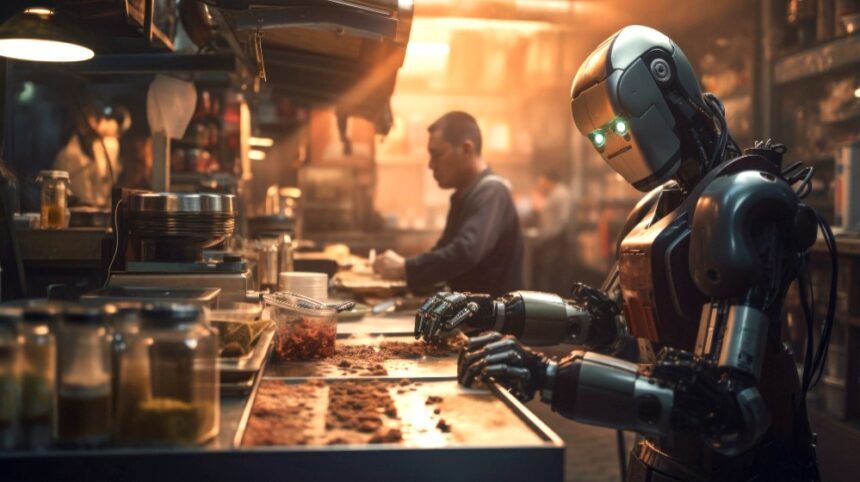impact of robotics on manufacturing job has become a pivotal economic and industrial shift in the United States. As a result, both new opportunities and challenges for the workforce have emerged. This comprehensive exploration will dissect robotics’s multifaceted impact on manufacturing jobs, utilizing a structured approach through various subtopics.
Historical Overview
Before Robotics
The pre-robotics era in U.S. manufacturing was characterized by labor-intensive processes, with limited automation primarily focused on assembly lines introduced by Henry Ford. This period highlighted the reliance on human labor for production, craftsmanship, and operational tasks.
Introduction of Robotics
The genesis of robotics in manufacturing can be traced back to the 1960s, when the Unimate, the first industrial robot, revolutionized automobile manufacturing. This event resulted in a new era of efficiency and productivity but also sparked the first debates on job displacement.
Technological Advancements
Advancements in Robotics Technology
From basic mechanical arms to sophisticated AI-powered robots, technological advancements have exponentially increased the capabilities and applications of robotics in manufacturing. Today’s robots are capable of performing complex tasks with precision and consistency.
Impact of Robotics on Production and Efficiency
Robotics has significantly boosted production rates and efficiency within the manufacturing sector. Swift and precise execution of tasks reduces production costs and improves product quality, avoiding human errors.

Integration with the Internet of Things (IoT)
Robots and other devices in manufacturing can communicate with each other using IoT. This is a critical improvement in technology. The communication integration enables an easy flow of information within the manufacturing environment. This enhanced connectivity empowers robots to make informed decisions based on real-time data from multiple sources, leading to increased efficiency and adaptability in production processes.
Development of Collaborative Robots (Cobots)
Another important technological advancement in the field of robotics is the development of collaborative robots, commonly referred to as ‘cobots.’ These robots are engineered to function alongside humans in a shared workspace, promoting a safe and productive working environment. Unlike traditional robots, cobots are equipped with sensors and AI capabilities that allow them to understand and react to their human counterparts, enhancing safety and fostering a more interactive and flexible manufacturing environment. This synergy between human workers and robots opens new avenues for productivity and innovation in manufacturing.
Workforce Transformation
Job Displacement Concerns
The automation of tasks previously performed by humans has led to valid concerns about job displacement. Many manual, repetitive jobs have been and continue to be replaced by machines, necessitating a shift in the workforce’s skills and roles.

As we stand on the brink of a technological revolution that will fundamentally alter the way we live, work, and relate to one another, the integration of robotics and artificial intelligence in the workplace could lead to significant displacements in the job market. It’s not just about the jobs that are lost, but also about the jobs that are transformed and the new jobs that are created. The real challenge lies in our ability to adapt and re-skill the workforce to harness the benefits of these changes. – Dr. Andrew McAfee, Co-Director of the MIT Initiative on the Digital Economy
Emergence of New Job Opportunities
While robotics has displaced specific jobs, it has also created new opportunities in areas like robot maintenance, programming, and supervision. The demand for skilled workers in robotics technology and data analysis has risen, reflecting a shift in the nature of manufacturing jobs.
Productivity and Competitiveness
The adoption of robotics has enhanced manufacturing productivity, allowing U.S. industries to remain globally competitive. Increased efficiency can lead to reduced production costs, encouraging companies to maintain or expand operations within the United States.
Wage Dynamics and Employment Patterns
Robotics’ impact on wages and employment patterns is complex. Some studies suggest that automation may suppress wages or limit job growth in certain areas. However, these studies also highlight the potential for increased demand in high-skilled jobs, potentially driving up wages in those sectors.
To read more comprehensive articles like this visit Peak Publisher
Key Challenges for the Employment Market
The integration of robotics into the workforce brings to light several critical challenges for the employment market. These challenges call for strategic planning, policy-making, and workforce development to mitigate negative impacts and harness the potential of robotics for economic growth and job creation. Below are the primary challenges that need to be addressed:
- Skill Gaps and Reskilling: As robotics evolve, there is a growing need for workers to acquire new skills. Bridging the skill gap and facilitating reskilling efforts for displaced workers is critical.
- Economic Inequality: The technological advancements in robotics could exacerbate economic inequalities if high-paying tech jobs are accessible only to a particular segment of the population while low-skilled jobs are automated.
- Adapting Education Systems: Education systems need to adapt to the changing job landscape. To prepare future generations for a robotics-centric world, STEM (science, technology, engineering, and mathematics) education must be incorporated with early and lifelong learning.
- Workplace Safety and Ethics: Ensuring safety in workplaces that use robotics, mainly where humans and robots collaborate, is vital. Furthermore, ethical concerns, including privacy and decision-making in AI, need to be addressed.
- Economic Displacement: While robotics can lead to job creation in some sectors, there is a risk of significant job displacement in others. Managing this displacement and preventing long-term unemployment is a major challenge.
- Policy and Regulatory Framework: Developing and implementing policies and regulations that encourage innovation while protecting workers’ rights and promoting equitable growth is essential.
- Social Acceptance: Overcoming resistance to robotics in the workplace from employees and unions requires transparent communication, demonstrating the benefits, and involving all stakeholders in the transition process.
To create an adaptable employment market in the automation age, collaboration is essential among governments, industries, educational institutions, and workers. Governments should develop policies and invest in training programs. Industries should identify future skills and offer training programs. Educational institutions should align with the changing job market and develop relevant curriculums. Workers should be agile, learn new skills, and retool for new job opportunities.
Future Prospects
Robotics and the Future Workforce
The continued evolution of robotics in manufacturing necessitates a forward-looking approach to workforce development, focusing on education, reskilling, and adaptability to technological changes.
Policy and Economic Strategies
To harness the benefits of robotics while mitigating its challenges, policymakers and industry leaders must implement strategies that support workforce transition, encourage innovation, and ensure economic inclusivity.
Sustainable Manufacturing Practices
The integration of robotics in manufacturing also opens a pathway to more sustainable and environmentally friendly production processes. Robots can play a vital role in creating a sustainable future by reducing waste and energy consumption with precision and efficiency. The future will likely see a greater emphasis on developing robotics technologies that support green manufacturing initiatives, reducing industries’ carbon footprints.
Collaboration Between Humans and Robots
The concept of cobots (collaborative robots) designed to work alongside humans safely is gaining traction. This evolution focuses on enhancing human capabilities rather than replacing them, promoting a symbiotic relationship between workers and robots. Solution is to develop more sophisticated robots that can learn and adapt to human workers’ needs and fostering an integrated workplace where the strengths of both humans and robots are optimized.
In the next decade, we’ll likely see a continued automation trend that could exacerbate workforce challenges, particularly for those in lower-skilled roles. However, the narrative shouldn’t be just about robots taking jobs; it’s also about the opportunities for human-robot collaboration to create new types of work. What’s crucial is the policy response to ensure these technologies lead to job creation rather than widespread unemployment. – Professor Erik Brynjolfsson, Director of the Stanford Digital Economy Lab
Advancements in Robot Programming
The emergence of more intuitive programming interfaces and the use of artificial intelligence to teach robots through observation and learning from humans could significantly lower the barrier to robot deployment in smaller manufacturing settings. This would democratize access to robotics technology, allowing more businesses to leverage these advancements for increased productivity.
Global Supply Chain Transformation
Robotics can transform global supply chains by enabling more localized production models. With robots, manufacturers can efficiently produce goods closer to the end consumers, reducing the need for extensive and complex supply chains. This shift towards localized manufacturing can lead to faster response times to market demands, reduced transportation costs, and bolstering local economies. The future of robotics in manufacturing could thus play a crucial role in reshaping international trade dynamics and promoting greater economic resilience.
Conclusion
The impact of robotics on manufacturing jobs in the U.S. underscores a critical period of transition and adaptation. By balancing technological advancement with workforce development and ethical considerations, the future of American manufacturing can be both innovative and inclusive, leveraging robotics to enhance productivity and job quality in the new digital age. As technology advances, success will depend on collaborative efforts and proactive measures to ensure accessibility for all. So, policymakers, industries, and workers alike need to work together to navigate this change and shape a prosperous future for manufacturing.
Frequently Asked Questions (FAQs)
Q. How can robotics exacerbate economic inequalities?
Robotics could exacerbate economic inequalities by creating a job market where high-paying tech jobs are accessible only to well-educated individuals while automating low-skilled positions, potentially widening the gap between different segments of the population.
Q. What challenges does the integration of robotics into the workplace present?
Challenges include adapting education systems to focus on STEM and lifelong learning, ensuring workplace safety and ethical considerations in robotics usage, managing economic displacement and unemployment risks, and developing policies for equitable growth.
Q. How do robotics influence sustainable manufacturing practices?
Robotics can lead to more sustainable and environmentally friendly production processes by improving precision and efficiency. Which can significantly reduce waste and energy consumption, and supporting global sustainability efforts.
Q. What are cobots, and how do they benefit the workforce?
Cobots work together with humans safely, enhancing human capabilities rather than replacing them. They promote a symbiotic relationship, optimizing the strengths of both humans and robots in the workplace.
Q. What advances in robot programming are anticipated?
Future advances include more intuitive programming interfaces and the use of artificial intelligence to teach robots through observation. Which will make it easier for smaller manufacturers to deploy robots for increased productivity.
Q. How can robotics transform global supply chains?
Robotics can enable more localized production models, allowing manufacturers to produce goods closer to end consumers. This can reduce the need for complex supply chains, lower transportation costs, respond faster to market demands, and strengthen local economies.







